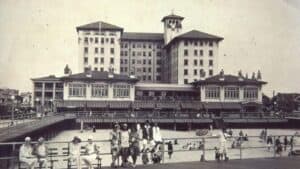On Flanders Field
Perched majestically overlooking the Atlantic, The Flanders Hotel in Ocean City, a venerable centenarian, holds a captivating tapestry of history, rumor, and enduring charm. Beyond its elegant facade lie tales of roaring twenties revelry, the glint of saltwater pools, and even the whisper of a spectral presence.
The genesis of The Flanders was a direct response to the burgeoning tourism spurred by the 1922 completion of the Delaware River Bridge, later christened the Benjamin Franklin Bridge, which promised a flood of auto-driving visitors to the South Jersey shores. Recognizing the imperative to compete with resorts like Atlantic City and its popular new Blenheim Hotel, the Ocean City Chamber of Commerce formed a committee. This committee, evolving into the Ocean Front Hotel Corporation, embarked on an ambitious venture: to construct a grand oceanfront resort. They successfully raised capital by selling shares to local investors, demonstrating a collective vision for Ocean City’s future.
For this ambitious project, they enlisted the talents of Ocean City native Vivian B. Smith, a local architect of considerable repute. Smith, whose impressive portfolio already included the 1915 City Hall, the 1924 Ocean City High School, and the iconic Music Pier in 1929, designed The Flanders with robust steel girders and concrete. This “fireproof” construction proved its worth dramatically in the great fire of 1927, which consumed every other boardwalk structure while The Flanders stood resolute and unharmed. The colossal undertaking cost $1.5 million at the time, a sum equivalent to nearly $30 million today.
Officially opening its doors in July 1923, the hotel was christened The Flanders, a name echoing the World War I battlefield, the Battle of Flanders Field. It boasted 232 well-appointed rooms, each with a private bath, a refreshing swimming pool, expansive sundecks, a variety of shops and restaurants, and a magnificent grand ballroom. A dedicated staff of front desk personnel, bellhops, and doormen ensured guests were meticulously catered to, swiftly earning The Flanders the moniker “The Jewel of the Southern Jersey Shore.”
In the aftermath of the 1927 fire, The Flanders capitalized on its fortuitous escape by acquiring the adjacent beachfront land. Here, they constructed three saltwater pools, which quickly became a vibrant hub for swimming events and attracted celebrities, including the legendary Olympian Johnny Weissmuller. These beloved pools, however, ceased operation in 1978 and the land was eventually sold, facilitating Playland’s expansion from a one-acre to a three-acre facility.
The Great Depression brought a change of ownership in 1929, and The Flanders was sold again in 1996 to James Dwyer, who transformed the 232 hotel rooms into 95 condominiums. After navigating periods of both prosperity and challenges, The Flanders underwent significant multi-million dollar renovations and improvements. Since the early 2000s, under the guiding hand of current hotel general manager Peter Voudouris, who also owns the parking lot and common areas, The Flanders has experienced a remarkable resurgence, thriving as both a premier hotel and a sought-after events center in Ocean City.
Beyond its public persona, The Flanders harbors a fascinating collection of lore and hidden gems. Deep beneath the hotel, below sea level, lies a full basement known as the “catacombs,” a maze of seven or eight expansive rooms. Whispers persist that these catacombs housed a speakeasy during the 1920s and 30s, complete with a bar and clandestine gambling rooms. It is also rumored to have served as a discreet meeting place for prominent figures of the mob from Philadelphia, New York, and Atlantic City. Within the elegant lobby, two original telephone booths stand as a nod to a bygone era. Adding to its self-sufficiency, The Flanders boasts its own on-site well and operates its own independent water system.
Perhaps the most intriguing tale associated with The Flanders is that of “The Lady in White,” said to be a spectral presence named Emily. Many who have encountered her describe a young woman in her early twenties, with long brown hair, clad in a white dress, and barefoot. She is most frequently reported in the lobby and on the second and fourth floors, known for her mischievous antics such as rattling doorknobs and flickering lights. Some have even reported hearing her singing. Lore suggests she was the girlfriend of a U.S. soldier tragically killed in World War I, her spirit forever lingering in the grand halls of The Flanders.
